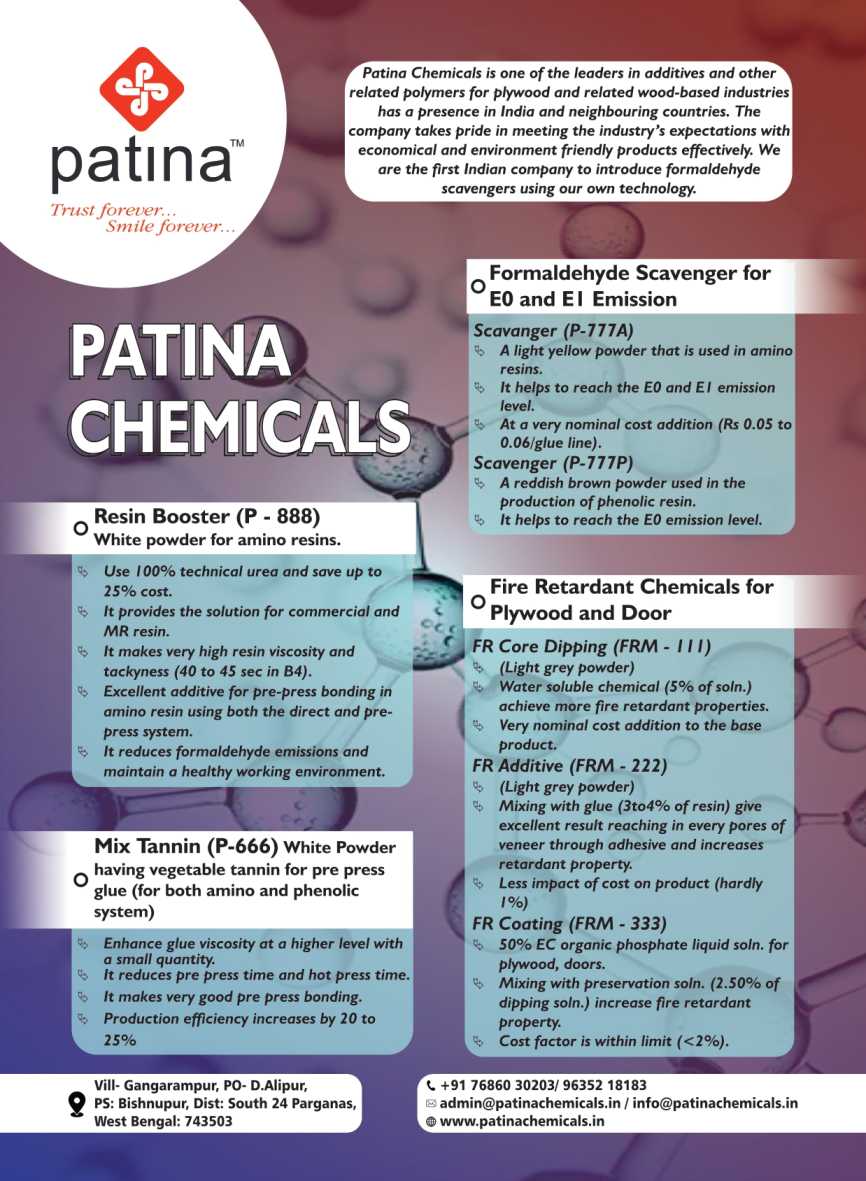
Integrated Development of Agroforestry and Wood-based Industries
- जुलाई 8, 2022
- 0
Integrated Development of Agroforestry and
Wood-based Industries-A Way Forward for Carbon Neutral Economy
1.0 Agroforestry and Private Forestry for Carbon Neutral Economy
Government of India (GOI), in the recently announced budget of 2022-23, has used ‘Agroforestry and Private Forestry’ as instruments to achieve the carbon neutral economy. Agroforestry coversshort rotation tree crops which are generally cultivated by farmers, while the private forestry covers medium and long rotation tree crops, which are generally planted by plantation companies or individuals in their land. India has almost reached the level of self-sufficiency in producing small sized wood through agroforestry but is still heavily dependent on imported timber due to shortage of large sized wood from the forests and the farmers cannot afford to produce it. The recent initiative of the GOI encouraging private forestry may serve the dual purpose of encouraging local production of large sized wood and mitigating the impact of climate change
Under Nationally Determined Contributions (NDCs), India has committed to createan additional CO2 sink of 2.5 to 3.0 billion tonnes by 2030 under the Paris Agreement of the UNFCCC. The plantations under agroforestry and private forestry not only sequester carbon but the wood products manufactured from their wood also store carbon during their lifetime. The focussed action on agroforestry and private forestry may help in achieving the targets under NDCs and will also provide momentum to move towards achieving the goal of having 33% of the geographical area under forest and tree cover as envisaged in National Forest Policy of 1988.
2.0 Present Status of Agroforestry
During the late seventies and eighties, some of the states have implemented self-funded as well as externally aided social forestry projects in which focus was on extension of agroforestry. The wood-based industry started meeting its demands of raw materials by establishing a direct relationship with the farmers. Due to focus on agroforestry, the area under Trees Outside Forests (TOFs) increased from 5.6% in 2001 to 8.9% of geographical area of India in 2021 and annual wood production increased from 69 to 85 million cubic metres as per the India State of Forest Reports(ISFRs). The area under agroforestry plantations would produce wood regularly and eighty to ninety percent of these areas will always remain under green cover helping in carbon sequestration. As the availability of timber declined from the forest areas and the farm wood could not substitute for the timber from forests entirely, the Government liberalised the import of timber in nineties. As per Sustainable Trade of Wood and Wood-based Products in India (2021), 15 million cubic metres roundwood equivalent of wood and wood products for about INR 450 billion, were imported.
To meet the shortage of raw materials, a few companies like WIMCO Seedlings Ltd. (UK) and ITC, Bhadrachalam Paperboard Ltd. (AP), etc., promoted farming of tree crops through providing quality plants, package of practices and assured buy back arrangements in 1980s. These models have ensured the backward integration of availability of raw material with wood-based industries. Similarly, Yamunanagar cluster of wood-based industries in the State of Haryana which is known as ‘plywood capital’ of the country, presentlyhas the capacity to manufacture about 40% plywood of the country. This cluster is the biggest market for farm wood and has benefitted all the stakeholders including the farmers, labourers, contractors, transporters, traders and industrialists. Hence, the integrated development of agroforestry and wood-based industry would ensure the faster growth of wood sector.
3.0 Issues in Growth of Agroforestry Sector and Action Required
3.1 Farmers: The farmers suffer mainly due to hassles in harvesting of trees and inter-state transportation of wood; poor quality of planting material in nurseries; inadequate extension services not supported by research and development; wide fluctuations in prices of wood due to long harvesting period; and no incentive for carbon sequestration. To resolve the above issues; firstly, there should be Pan-India amendments to the rules on felling trees and inter-state transportation of wood through developing an online system for registration of plantations, felling of trees and ensuring seamless movement of wood. Secondly, there should be a framework for accreditation of private nurseries for providing quality planting stock. Thirdly, the wood markets with effective networking may be established. Fourthly, the symbiotic models of ITC, WIMCO, etc., may be promoted. Fifthly, the carbon trading may be facilitated and sixthly, intensive R&D efforts may be made.
3.2 Wood-based Industry: The wood-based industry mainly suffers due to complicated licensing policy as the new licenses/expansion of units are issued only after assessing the increased availability of wood; costly farm wood competing with agricultural produce; non-certified farm wood and stiff competition with imported wood products. To resolve the above issues;firstly, wood-based industry may be treated at par with the food processing industry. Secondly, composite wooden panels may be promoted to reduce the demand of solid wood in the long run. Thirdly, upgradation of wood-based industry may be facilitated and fourthly, extensive training and development programmes for skilled manpower.
4.0 VISION-2047 (Amrit Kaal) and Projected Benefits
The following VISION-2047 is proposed during Amrit Kaal (period of 25 years).
- Additionally, 10 million ha of farmlands (3% of geographical area of India) may be brought under plantations, out of which five million ha may be brought under short rotation trees and another five million ha under medium and long rotation trees.
- Development of 100 clusters of wood-based industries
- Making India from a ‘importing wood products to exporting wood products’ country
4.1 Projected Benefits: The projected benefits from the above plan will be
- Agroforestry: The annual production of wood from plantations of short rotation trees like poplar, eucalyptus, bakain, etc., would be about 100 million cubic metres of timber worth about INR 420 billion and would generate employment of about 371 million person days (writer’s estimate).
- Private Forestry: The annual production of timber from plantations of medium rotation trees like gamhar, kadam, silver oak, kikar and long rotation trees like teak and shisham would be about 37 million cubic metres of timber worth about INR 645 billion and would generate employment of about 147million person days (writer’s estimate).
India becoming anexporting wood products’ country
4.1 Policy Initiatives
The following policy initiatives need to be taken for the faster development of the wood sector.
- Setting up National Agroforestry Board (MoCI)
- Enactment of legislation on TOF (MoEFCC)
- Liberalising licensing policy for wood-based industry based on farm wood (MoEFCC)
- Reducing Goods and Services Tax on wood products manufactured from farm wood (MoF)
- Aggressively promoting private forestry by providing incentives like discounted loans, capital subsidies and tax concessions (MoF)
- Reviewing export and import policy to encourage domestic production of wood and wood products (MoCI)
- Promoting voluntary certification of farm wood and regulating import of illegal timber (MoCI)
It is heartening that the initiatives and reforms for development of agroforestry sector are being monitored at the level of PMO. The implementation of the initiatives will create large scale employment opportunities, increase the income of farmers, improve business opportunities for various stakeholders, increase revenue for the Government including earning of foreign exchange. The farm wood would not only meet the demands of wood-based industry but would also be able to meet the ecological requirements of the country.
कृषि वानिकी और लकड़ी आधारित उद्योगों का एकीकृत विकास
कार्बन तटस्थ अर्थव्यवस्था के लिए आगे बढ़ना
1.0 कार्बन तटस्थ अर्थव्यवस्था के लिए कृषि वानिकी और निजी वानिकी
भारत सरकार (GoI) ने 2022-23 के हाल ही में घोषित बजट में, कार्बन तटस्थ अर्थव्यवस्था को प्राप्त करने के लिए श्एग्रोफोरेस्ट्री और निजी वानिकीश् का उपयोग उपकरणों के रूप में किया है। एग्रोफोरेस्ट्री में लघु रोटेशन पेड़ की फसलें शामिल हैं जो आम तौर पर किसानों द्वारा खेती की जाती हैं, जबकि निजी वानिकी मध्यम और लंबी रोटेशन वाली वृक्ष फसलों को शामिल करता है, जो आमतौर पर वृक्षारोपण कंपनियों या व्यक्तियों द्वारा अपनी भूमि में लगाए जाते हैं। भारत कृषि वानिकी के माध्यम से छोटे आकार की लकड़ी के उत्पादन में लगभग आत्मनिर्भरता के स्तर पर पहुंच गया है, लेकिन अभी भी जंगलों से बड़े आकार की लकड़ी की कमी के कारण आयातित लकड़ी पर बहुत अधिक निर्भर है और किसान इसका उत्पादन नहीं कर सकते हैं। निजी वानिकी को प्रोत्साहित करने वाली भारत सरकार की हालिया पहल बड़े आकार की लकड़ी के स्थानीय उत्पादन को प्रोत्साहित करने और जलवायु परिवर्तन के प्रभाव को कम करने के दोहरे उद्देश्य की पूर्ति कर सकती है।
राष्ट्रीय स्तर पर निर्धारित योगदान (NDC) के तहत, भारत ने UNFCCC के पेरिस समझौते के तहत 2030 तक 2.5 से 3.0 बिलियन टन का अतिरिक्त सीओ 2 सिंक बनाने के लिए प्रतिबद्ध किया है। कृषि वानिकी और निजी वानिकी के तहत वृक्षारोपण न केवल कार्बन को अलग करता है बल्कि उनकी लकड़ी से निर्मित लकड़ी के उत्पाद भी अपने जीवनकाल में कार्बन का भंडारण करते हैं। एग्रोफोरेस्ट्री और निजी वानिकी पर केंद्रित कार्रवाई (NDF) के तहत लक्ष्यों को प्राप्त करने में मदद कर सकती है और 1988 की राष्ट्रीय वन नीति में परिकल्पित वन और वृक्षों के कवर के तहत भौगोलिक क्षेत्र का 33 प्रतिशत होने के लक्ष्य को प्राप्त करने की दिशा में गति प्रदान करेगी।
2.0 कृषि वानिकी की वर्तमान स्थिति
सत्तर और अस्सी के दशक के अंत के दौरान, कुछ राज्यों ने स्व-वित्तपोषित और बाहरी सहायता प्राप्त सामाजिक वानिकी परियोजनाओं को लागू किया है जिसमें कृषि वानिकी के विस्तार पर ध्यान केंद्रित किया गया था। लकड़ी आधारित उद्योग ने किसानों के साथ सीधा संबंध स्थापित करके कच्चे माल की अपनी मांगों को पूरा करना शुरू कर दिया। एग्रोफोरेस्ट्री पर ध्यान केंद्रित करने के कारण, वनों के बाहर पेड़ों (ToF) के तहत क्षेत्र 2001 में 5.6 प्रतिशत से बढ़कर 2021 में भारत के भौगोलिक क्षेत्र का 8.9 प्रतिशत हो गया और भारत के वन राज्य के रेपोर्ट ISFR अनुसार वार्षिक लकड़ी का उत्पादन 69 से बढ़कर 85 मिलियन क्यूबिक मीटर हो गया। कृषि वानिकी वृक्षारोपण के तहत क्षेत्र नियमित रूप से लकड़ी का उत्पादन करेगा और इनमें से अस्सी से नब्बे प्रतिशत क्षेत्र हमेशा कार्बन पृथक्करण में मदद करने के लिए हरित आवरण में रहेंगे। चूंकि वन क्षेत्रों से लकड़ी की उपलब्धता कम हो गई और खेत की लकड़ी पूरी तरह से जंगलों से लकड़ी का विकल्प नहीं बन सकी, इसलिए सरकार ने नब्बे के दशक में लकड़ी के आयात को उदार बना दिया। भारत में ‘लकड़ी और लकड़ी आधारित उत्पादों के सतत व्यापार’ (2021) के अनुसार, लगभग 450 बिलियन रुपये में लकड़ी और लकड़ी के उत्पादों के बराबर 1.5 मिलियन क्यूबिक मीटर गोल लकड़ी का आयात किया गया था।
कच्चे माल की कमी को पूरा करने के लिए, कुछ कंपनियों जैसे विमको सीडलिंग्स लिमिटेड (यूके) और ITC, भद्राचलम पेपरबोर्ड लिमिटेड (AP), आदि ने गुणवत्ता वाले पौधे, प्रथाओं के पैकेज और सुनिश्चित खरीद वापस प्रदान करके पेड़ फसलों की खेती को बढ़ावा दिया। 1980 के दशक में व्यवस्था इन मॉडलों ने लकड़ी आधारित उद्योगों के साथ कच्चे माल की उपलब्धता के पिछड़े एकीकरण को सुनिश्चित किया है। इसी तरह, हरियाणा राज्य में लकड़ी आधारित उद्योगों का यमुनानगर समूह, जिसे देश की श्प्लाईवुड कैपिटलश् के रूप में जाना जाता है, वर्तमान में देश के लगभग 40 प्रतिशत प्लाईवुड के निर्माण की क्षमता रखता है। यह क्लस्टर कृषि लकड़ी का सबसे बड़ा बाजार है और इसने किसानों, मजदूरों, ठेकेदारों, ट्रांसपोर्टरों, व्यापारियों और उद्योगपतियों सहित सभी हितधारकों को लाभान्वित किया है। इसलिए, कृषि वानिकी और लकड़ी आधारित उद्योग के एकीकृत विकास से लकड़ी क्षेत्र का तेजी से विकास सुनिश्चित होगा।
3.0 कृषि वानिकी क्षेत्र के विकास में मुद्दे और आवश्यक कार्रवाई
3.1 किसानः किसानों को मुख्य रूप से पेड़ों की कटाई और लकड़ी के अंतर-राज्यीय परिवहन में परेशानी का सामना करना पड़ता है; नर्सरी में रोपण सामग्री की खराब गुणवत्ता; अपर्याप्त विस्तार सेवाएं जो अनुसंधान और विकास द्वारा समर्थित नहीं हैं; कटाई की लंबी अवधि के कारण लकड़ी की कीमतों में व्यापक उतार-चढ़ाव; और कार्बन ज़ब्ती के लिए कोई प्रोत्साहन नहीं। उपरोक्त मुद्दों को हल करने के लिए, सबसे पहले, वृक्षारोपण के पंजीकरण, पेड़ों की कटाई और लकड़ी की निर्बाध आवाजाही सुनिश्चित करने के लिए एक ऑनलाइन प्रणाली विकसित करके पेड़ों की कटाई और लकड़ी के अंतर-राज्यीय परिवहन पर नियमों में अखिल भारतीय संशोधन होना चाहिए। दूसरे, गुणवत्तापूर्ण रोपण स्टॉक प्रदान करने के लिए निजी नर्सरी की मान्यता के लिए एक रूपरेखा होनी चाहिए। तीसरा, प्रभावी नेटवर्किंग के साथ लकड़ी के बाजार स्थापित किए जा सकते हैं। चौथा, आईटीसी, विमको आदि के सहजीवी मॉडल को बढ़ावा दिया जा सकता है। पांचवां, कार्बन व्यापार को सुगम बनाया जा सकता है और छठे, गहन अनुसंधान एवं विकास प्रयास किए जा सकते हैं।
3.2 लकड़ी आधारित उद्योग : लकड़ी आधारित उद्योग मुख्य रूप से जटिल लाइसेंसिंग नीति के कारण प्रभावित होते हैं क्योंकि नए लाइसेंस/इकाइयों के विस्तार लकड़ी की बढ़ी हुई उपलब्धता का आकलन करने के बाद ही जारी किए जाते हैं। कृषि उपज के साथ प्रतिस्पर्धा करने वाली महंगी कृषि लकड़ी; गैर-प्रमाणित कृषि लकड़ी और आयातित लकड़ी के उत्पादों के साथ कड़ी प्रतिस्पर्धा। उपरोक्त मुद्दों को हल करने के लिए, सबसे पहले, लकड़ी आधारित उद्योग को खाद्य प्रसंस्करण उद्योग के समान माना जा सकता है। दूसरे, लंबे समय में ठोस लकड़ी की मांग को कम करने के लिए मिश्रित लकड़ी के पैनलों को बढ़ावा दिया जा सकता है। तीसरा, लकड़ी आधारित उद्योग के उन्नयन को सुगम बनाया जा सकता है और चौथा, कुशल जनशक्ति के लिए व्यापक प्रशिक्षण और विकास कार्यक्रम।
4.0 विजन-2047 (अमृत काल) और अनुमानित लाभ
अमृत काल (25 वर्ष की अवधि) के दौरान निम्नलिखित विजन-2047 प्रस्तावित है।
- अतिरिक्त, 10 मिलियन हेक्टेयर कृषि भूमि (भारत के भौगोलिक क्षेत्र का 3 प्रतिशत) को वृक्षारोपण के तहत लाया जा सकता है, जिसमें से पांच मिलियन हेक्टेयर को छोटे रोटेशन के पेड़ों के तहत लाया जा सकता है और अन्य पांच मिलियन हेक्टेयर को मध्यम और लंबे रोटेशन के पेड़ों के तहत लाया जा सकता है।
- लकड़ी आधारित उद्योगों के 100 समूहों का विकास
- भारत को ‘लकड़ी के उत्पादों के आयात से निर्यात करने वाले लकड़ी के उत्पादों’ वाला देश बनाना
4.1 अनुमानित लाभः उपरोक्त योजना से अनुमानित लाभ होंगे
- एग्रोफोरेस्ट्रीः पॉपलर, यूकेलिप्टस, बाकेन आदि जैसे छोटे रोटेशन वाले पेड़ों के वृक्षारोपण से लकड़ी का वार्षिक उत्पादन लगभग 420 बिलियन रुपये मूल्य की लकड़ी का लगभग 100 मिलियन क्यूबिक मीटर होगा और इससे लगभग 371 मिलियन व्यक्ति दिवसों का रोजगार पैदा होगा (लेखक का आकलन)।
- निजी वानिकीः गम्हार, कदम, सिल्वर ओक, किकर और सागौन और शीशम जैसे लंबे रोटेशन वाले पेड़ों के वृक्षारोपण से लकड़ी का वार्षिक उत्पादन लगभग 37 मिलियन क्यूबिक मीटर लकड़ी का होगा जिसकी कीमत लगभग 645 बिलियन रुपये होगी और इससे रोजगार पैदा होगा। लगभग 147 मिलियन व्यक्ति दिवस (लेखक का अनुमान)।
- भारत लकड़ी के उत्पादों का निर्यात करने वाला देश बन रहा है
4.1 नीतिगत पहल
काष्ठ क्षेत्र के तेजी से विकास के लिए निम्नलिखित नीतिगत पहल करने की आवश्यकता है।
- राष्ट्रीय कृषि वानिकी बोर्ड की स्थापना (MoCI)
- ज्व्थ् पर कानून का अधिनियमन (MoEFCC)
- फार्म वुड पर आधारित लकड़ी आधारित उद्योग के लिए लाइसेंसिंग नीति को उदार बनाना (MoEFCC)
- खेत की लकड़ी से निर्मित लकड़ी के उत्पादों पर माल और सेवा कर को कम करना (MoF)
- रियायती ऋण, पूंजीगत सब्सिडी और कर रियायत (एमओएफ) जैसे प्रोत्साहन प्रदान करके निजी वानिकी को आक्रामक रूप से बढ़ावा देना
- लकड़ी और लकड़ी के उत्पादों के घरेलू उत्पादन को प्रोत्साहित करने के लिए निर्यात और आयात नीति की समीक्षा करना (MoCI)
- खेत की लकड़ी के स्वैच्छिक प्रमाणीकरण को बढ़ावा देना और अवैध लकड़ी के आयात को विनियमित करना (MoCI)
यह खुशी की बात है कि कृषि वानिकी क्षेत्र के विकास की पहलों और सुधारों की निगरानी पीएमओ (PMO) के स्तर पर की जा रही है। पहल के कार्यान्वयन से बड़े पैमाने पर रोजगार के अवसर पैदा होंगे, किसानों की आय में वृद्धि होगी, विभिन्न हितधारकों के लिए व्यापार के अवसरों में सुधार होगा, विदेशी मुद्रा की कमाई सहित सरकार के लिए राजस्व में वृद्धि होगी। खेत की लकड़ी न केवल लकड़ी आधारित उद्योग की मांगों को पूरा करेगी बल्कि देश की पारिस्थितिक आवश्यकताओं को भी पूरा करने में सक्षम होगी।
































































